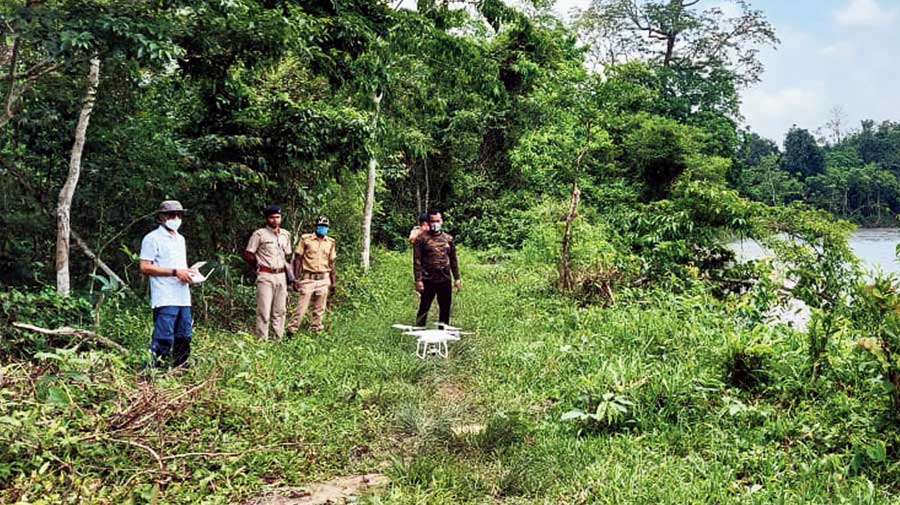The forest department on Wednesday unveiled four mini trucks, which will ferry men and equipment to control marauding elephants.
Every truck, called Airavat, is GPS-enabled and comes with a drone to be used for aerial surveillance of elephant herds. There’s space to keep tranquilliser guns, hooters, a variety of torches and an assortment of slings, nets and iron shackles.
The vehicles and drones are more effective in controlling elephants than the traditional hula parties — squads with fireballs and crackers deployed to chase away elephants straying into human settlements, according to foresters and NGO workers. Fire often puts both men and the animal at risk.
The four new vehicles take the fleet of such mini trucks to 11, a forest official said. The introduction of the vehicles started in 2016 and drones were tagged along from 2018, the official said.
On Wednesday, the mini trucks were unveiled at Ausgram in the East Burdwan district of the Burdwan forest division by Rajib Banerjee, the state forest minister. A mini truck and drone each will head for Purulia, Kangsabati and Gorumara divisions and one pair will remain for Burdwan forests.
“There are 11 elephant-inhabited divisions, each of which now has a pair of a vehicle and a drone. Ideally, we want all 33 divisions to have one such pair,” Ravi Kant Sinha, the state’s chief wildlife warden, said. “The vehicle will be of great help in managing man-animal conflict, be it any animal.
“The drone tagged with each truck can fly up to a height of 300m. It can cover a span of close to 2km. Aerial surveys are often faster and more effective than ground surveillance. A drone can quickly spot a herd, its movement or an elephant straying away from the herd.”
Each mini truck is equipped with a variety of lights — torches and searchlights to make way through dense and dark forests at night and scare animals and fog lights — hooters, a portable generator, and a radio transmitter for emergency connection with the control base. A set of darts, a tranquillising gun and a set of tranquillising medicines and a dismantled trap cage is available in each vehicle apart from a set of ropes, slings and iron shackles to be used to lift heavy animals with cranes.
“Cranes can’t be ferried in the trucks. If need be, we will organise it,” a forest official said.
Herds of elephants from Dalma enter the forests of Jhargram, Purulia, Bankura and West Midnapore in south Bengal every year and spend several months before heading back to Jharkhand. The forests of south Bengal are interspersed with human settlements and farmlands that provide easy source of food for the elephants.
Some herds have made south Bengal forests their home and do not go back to Jharkhand at all, the forest official said.
The human-elephant conflict has gone up over the years. According to a written reply in Parliament by the Centre, 2,381 people in the country died in elephant raids from 2014-15 to 2018-19. Most of them (403) were from Bengal.
The state is among the top few when it comes to unnatural elephant deaths (in train accidents or electrocution). In the same period, 39 elephants died of electrocution in Bengal.
A string of elephant electrocutions has taken place in the state in the past two months.











